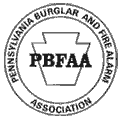
|
Terminal 1 |
Terminal 2 - 3 |
Terminal 4 |
Earth Ground The earth ground must be connected to a dedicated metal stake or cold water pipe using a 12 gauge or larger solid copper wire. DO NOT use electrical, gas or telephone grounds. Shields from the keypad or card reader cables must also connect to terminal 1. |
AC or DC Input Power The System 1 accepts 12 to 24 volts AC or DC. If AC is used, a 16.5 volt 15 VA transformer is recommended. If DC is used, terminals 2 and 3 are not polarity sensitive. The System 1 requires a minimum of 250 milli amps. |
(+) Voltage Output The System 1 has a selectable output voltage of 5 or 12 volts DC. This output is only to be used to power card readers or the LED on the remote keypad. The voltage is selected at the jumper labeled J2. This output CANNOT be used to power any other external device. The output on terminal 4 is fused at 1/2 amp. |
Terminal 5 |
Terminal 6 |
Terminal 7 - 10 |
(-) Common This is the System 1's common power supply negative for card readers and keypads. |
(-) LED Driver This is a negative output voltage for lighting a Light Emitting Diode(LED). When the main relay is activated the LED on the keypad or card reader will light to show that a valid code/card was entered. |
BCD Keypad All keypads and Data Chips used with the System output a Binary Code Decimal BCD output. BCD has four data lines. |
Terminal 11 |
Terminal 12 |
Terminal 13 |
DATA 1 Wiegand and Proximity readers require two data lines, data 1 and data 0. Terminal 11 is the data 1 input. Mag Stripe readers do not use this terminal. |
DATA 0 This terminal serves as the data 0 connection for Wiegand and Proximity readers and as the clock input for Magnetic Stripe or Bar Code readers. |
DATA This terminal is used only as the Magnetic Stripe or Bar Code data input. |
Terminal 14 |
Terminal 15 |
Terminal 16 - 18 |
RTE Input 14 is the Request To Exit or RTE input line. Whenever 14 is shorted to terminal 5 common (-), the main relay will activate as if a valid code or card was entered. RTE contact must be open circuit. |
Door Ajar This input serves three functions at the same time and uses a closed circuit switch contact mounted to the door. This switch is a typical alarm type magnetic switch and must be closed when the door is closed for proper operation. Please Note: If any of these features are not used, place a jumper between Terminals 5 and 15. |
Main Relay The contacts are rated at 5 AMPS 30 volts AC or DC. They can be used to switch power to a lock or gate, or arm / disarm an alarm system. Terminal 16 is Normally Open, 17 is Common, and 18 is Normally Closed. |
Terminal 19 - 20 |
Terminal 21 - 23 |
|
Shunt Contacts The contacts are rated at 5 AMPS 30 volts AC or DC. They can be used to shunt a door contact. This set of contacts follows the main relay because they activate at the same time the main relay activates. |
Aux Relay The contacts are rated at 1 AMP 30 volts AC or DC. They activate whenever a door ajar or forced entry condition occurs. |



